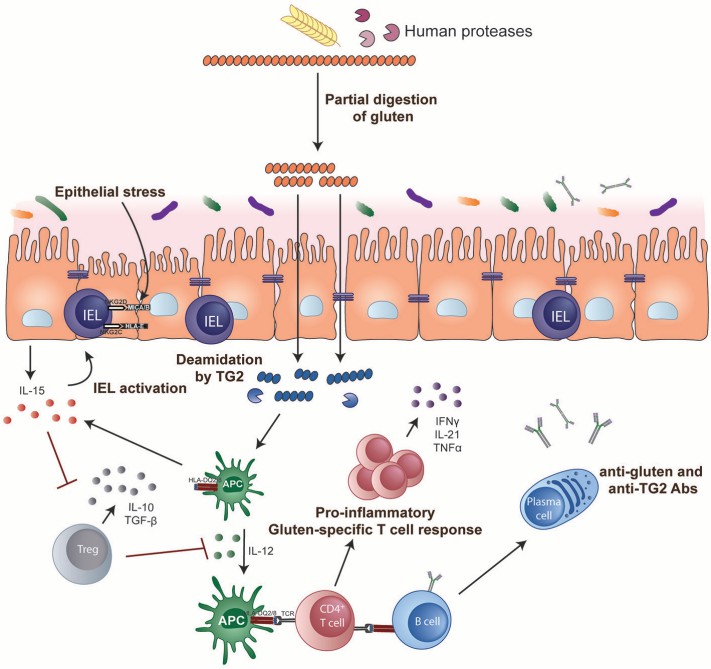NAA Associated Celiac Disease
The association between celiac disease and the presence of natural autoantibodies (NAA) has generated interest in the medical research field. With years of experience in natural autoantibody (NAA) detection and analysis based on celiac disease, Creative Biolabs is confident in providing a series of reliable and high-quality NAA services aided by our innovate and advanced techniques such as antigen microarrays, western blotting, and ELISA.
What Is Celiac Disease?
Celiac disease is an autoimmune disease (gluten-sensitive enteropathy), sometimes called sprue or coeliac. The disease is caused by consuming gluten, a protein found in wheat, barley, and rye. If a person with celiac disease eats foods containing gluten, her or his immune system will respond by damaging the finger-like villi of the small intestine. If untreated, the disease will result in long-term digestive problems and prevent from getting nutrients you need.
 Fig.1 Key steps in celiac disease pathogenesis.1
Fig.1 Key steps in celiac disease pathogenesis.1
Symptoms of Celiac Disease
People with celiac disease may experience digestive symptoms or symptoms in other parts of the body. And the symptoms of celiac disease can vary greatly and are different in children and adults. The most common symptoms in children include abdominal bloating and pain, chronic diarrhea, vomiting, constipation, weight loss, fatigue, irritability, and behavioral issues, dental enamel defects of the permanent teeth, delayed growth and puberty, failure to thrive, and Attention Deficit Hyperactivity Disorder (ADHD). The most common symptoms in adults are diarrhea, fatigue, and weight loss. Adults may also experience bloating and gas, abdominal pain, nausea, constipation, and vomiting.
What Is the Cause of Celiac Disease?
Celiac disease happens when the body's immune system overreacts to gluten in food, the reaction damages the small intestine. The cause of celiac disease is not clear. However, some researches have shown that genetic factors, eating foods containing gluten and environmental factors are associated with the occurrence of celiac disease.
- Genetics - Celiac disease is a genetic disorder, usually tending to occur in families. Some gene variants seem to increase the risk of developing the disease.
- Environmental factors - Such as viral infections, surgery, or some emotional trauma.
- Some complications - The disease is most common among people who have had other diseases like Down syndrome, type 1 diabetes, Turner syndrome, Addison's disease, or rheumatoid arthritis.
How to Diagnose Celiac Disease?
Because the damage of celiac disease to the intestine is very slow, and the symptoms are so varied, it takes years before someone gets a diagnosis. Specialists think that only 20% of people with celiac disease ever get a proper diagnosis. Doctors may diagnose celiac disease based on a combination with a medical and family history, a physical exam, blood tests, an intestinal biopsy, a skin biopsy, and genetic tests.
NAA test is one of the important test items in the diagnosis of celiac disease. NAA is mostly secreted by B1 cell and act as an essential role in the normal immune system and autoimmune diseases. During the development of celiac disease, NAA is over secreted and mistakenly attack the self-tissues thereby causing inflammation and disease. Hence, NAA test helps to diagnose Celiac Disease. The following is the key NAA markers associated with celiac disease.
| Natural Autoantibodies Targets in Celiac Disease | |||
| Anti-Transglutaminase 2 (TG2) | Anti-Transglutaminase 3 (TG3) | Anti-Factor XIII | Anti-Actin |
| Anti-Calreticulin | Anti-Gangliosides | Anti-Collagens | Anti-Synapsin I |
| Anti-Zonulin | Anti-Cardiolipin | Anti-ATP Synthase β Chain | Anti-Enolase α |
Creative Biolabs is committed to offering the best and comprehensive NAA services based on our advanced technology and experienced scientists. In addition, we also provide a series of custom NAA service to meet customers' special purpose of their project.
Please feel free to contact us for more details or a detailed quote.
Reference:
- Tye-Din, Jason A., Heather J. Galipeau, and Daniel Agardh. "Celiac disease: a review of current concepts in pathogenesis, prevention, and novel therapies." Frontiers in pediatrics 6 (2018): 350.
Choosing natural autoantibody (NAA) microarray to profile autoantibody repertoire and reveal novel disease's marker.
- NAA Services for Anti-Transglutaminase 2 Antibodies (ATG2A)
- NAA Services for Anti-Transglutaminase 3 (TG3) Antibodies
- NAA Services for Anti-Factor XIII Antibodies
- NAA Services for Anti-Actin Antibodies
- NAA Services for Anti-Calreticulin Antibodies
- NAA Services for Anti-Gangliosides Antibodies
- NAA Services for Anti-Collagens Antibodies
- NAA Services for Anti-Synapsin I Antibodies
- NAA Services for Anti-Zonulin Antibodies
- NAA Services for Anti-Cardiolipin Antibody
- NAA Services for Anti-ATP Synthase β Chain
- NAA Services for Anti-Enolase α
Related Services:
- NAA Associated Systemic Lupus Erythematosus (SLE)
- NAA Associated Rheumatic Diseases
- NAA Associated Sjögren's Syndrome (SS)
- NAA Associated Myasthenia Gravis (MG)
- NAA and Sjogren's Syndrome

